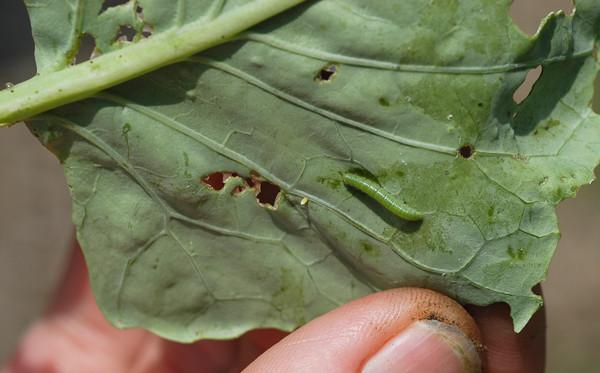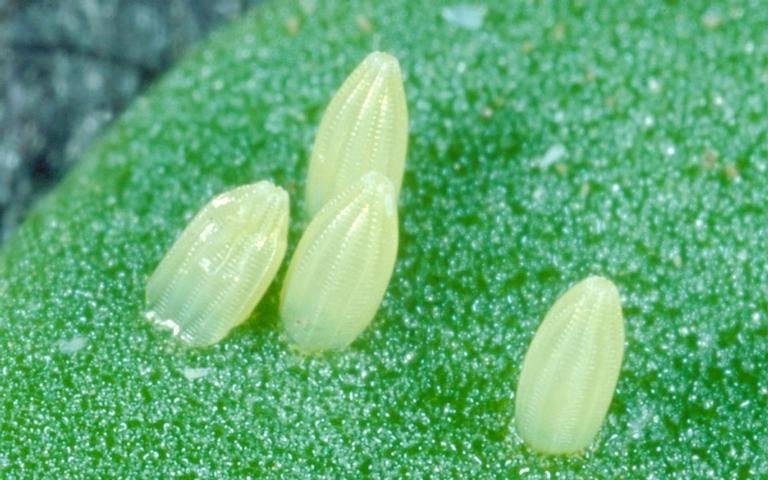
Appearance
- Eggs: Tiny, white to yellowish colored, bullet-shaped, ribbed eggs usually laid singly, on end.
- Larvae: Velvety green caterpillars with a single yellow stripe down the center of the back, and yellow spots or a broken yellow line along each side. About 1 1/4" long in final instar stage.
- Pupae: Chrysalis about 1" long with one dorsal and two side "fins." Color varies, but usually matches background: yellow, gray, green, brownish are common.
- Adults: Butterfly with 2" wingspan. Wings are white on top, usually with black tips and 2 or 3 black spots, and yellowish underneath.

Phil Sloderbeck, Kansas State University, Bugwood.org

Life cycle/habits
- Overwinter as pupa or chrysalis in plant debris and emerge as butterflies in spring.
- Butterflies are very active, flitting from host plant to weedy flowers, sipping nectar and laying eggs on the undersides of outer leaves of host plants.
- Larvae feed on leaves and sometimes bore into broccoli or cabbage heads.
- Pupae are attached to food sources or nearby objects by silken threads.
- Two to four, or even more, generations are produced per year.
Host plants
- Cole crops (a.k.a. crucifers or brassicas), including cabbage, broccoli, Brussel sprouts, cauliflower, collards, kale, turnip, and radish, etc., and many related weeds.
Signs/symptoms
- Larval feeding causes damage; adult butterflies feed only on nectar, causing no damage.
- Larval feeding initially produces small, smooth feeding holes in leaves, which soon enlarge until the entire leaf is consumed, leaving only the midrib.
- Entire plant may be defoliated. Damaged young plants may be unable to produce heads.
- Larvae sometimes bore into heads.
- Large amounts of dark green fecal pellets will be scattered on or beneath the plants.
Monitoring
- Be alert for small white butterflies flitting among cole crops.
- Watch for irregular feeding holes that enlarge. Leaves or entire plants may be skeletonized.
- Well-camouflaged larvae can be spied resting on leaf midribs.
- Look for dark green fecal pellets under areas of feeding activity.
- To determine if larvae have bored into heads, soak harvested heads in salty water. Larvae will float to the surface.
Prevention/control
- Remove plant debris after the growing season to eliminate overwintering sites.
- Floating row cover prevents egg-laying.
- Fast-maturing cultivars sustain less damage.
- Handpick larvae.
- Bacillus thuringiensis (Bt), an "organic" microbial insecticide, is highly effective on younger caterpillars.
- Spinosad, neem, and pyrethrum are effective "organic" insecticides. Brassica leaves are slick, so add a spreader-sticker to the sprayer tank.
- Many different diseases, predators, and parasitoids reduce larvae numbers naturally. (Pollen-rich flowers attract predators.)
- Avoid broad-spectrum insecticides, like Sevin, that harm beneficial insects, and birds.
- Larvae infected with granulosis virus or nuclear polyhedrosis virus can be collected, soaked in water, and made into a microbial insecticide spray to infect healthy larvae.
- Turnip, rutabaga, and kale are less favored by cabbageworms.
